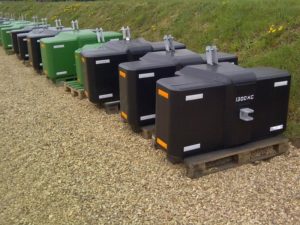As with cars, those that are weightier at the rear end over the tires often have fewer problems obtaining traction when moving off. This is just simple mathematics and generally cannot be beaten. Older style tractors used a very simplistic way of creating ballast with a large heavy beam of steel or iron over the rear wheels. Nowadays, there are far more complex and modern ways of achieving the same target.
Transportation vehicles are different to tractors in the way in which they move. A stable vehicle which digs for example on the spot will need weight to keep it steady, however this becomes an issue when a tractor or seeder needs to move whilst doing another action at the same time; too much weight and it can’t roll along. The tractor might already be pulling a heavy load of holding up tones of soil for example in its bucket, so this weight will keep it down naturally.
 There are however, some issues with traction in such large vehicles, and both are dealt with differently depending on the application for which they are used for. The newer tractors and heavy-duty vehicles, which have front mounting implements such as forklift spokes or buckets, have what is called a shifting weight. This works cleverly by moving weight from over the back wheels further towards the front, to keep an even ballast throughout.
There are however, some issues with traction in such large vehicles, and both are dealt with differently depending on the application for which they are used for. The newer tractors and heavy-duty vehicles, which have front mounting implements such as forklift spokes or buckets, have what is called a shifting weight. This works cleverly by moving weight from over the back wheels further towards the front, to keep an even ballast throughout.
Some tractors, which have their implements at the rear, have less of an issue. Because the larger wheels are at the back, along with the bulky tillage attachments or carry buckets, a natural weight distribution is caused so little weight needs to be shifted manually. As the forward motion slows down, the weight can shift evenly to where it is required most.
Have you ever been to a country show and watched tractor-pulling competitions? This is a very extreme way of demonstrating how weight can affect how a tractor moves and how easily. The tractors pull a weighted sledge behind them, and the further it moves along the course, the further the weight on the sledge moves towards its back wheels. This causes a resistance on the pulling power of the tractor as it rides along, which increases steadily. You will soon visually be able to see the effects that this has on the vehicle itself, it will begin to slow down quite rapidly in front of your eyes as this happens.
Many different types of tractors can be used for this type of pulling competition, from regular farm tractors to heavy duty minding tractors with a lot more power. It is not necessarily the more powerful vehicles which come up trumps however, as they have their own weight distribution to consider also. The distances that they pull are only short as they can kick out a lot of steam and cause a great noise, plus they need not be long enough to cause any serious strain to the engine.

